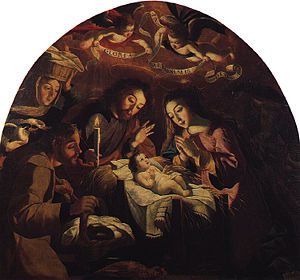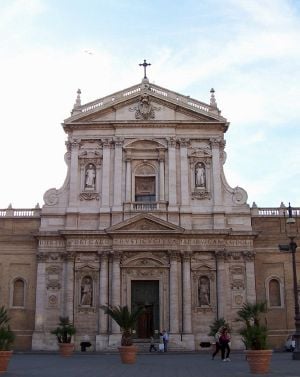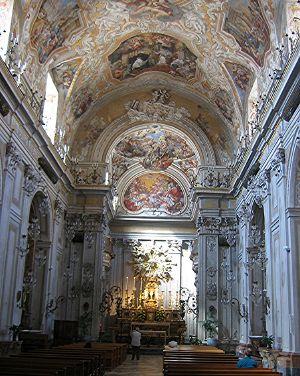Difference between revisions of "Baroque art" - New World Encyclopedia
Mihir Shah (talk | contribs) |
Mihir Shah (talk | contribs) |
||
| Line 47: | Line 47: | ||
''Landscape with the Flight into Egypt'' | ''Landscape with the Flight into Egypt'' | ||
In his landscapes, Carracci principally strays away from the high point of view so that the figures in the scene are at the same eye level as the viewer. A second, more discernable characteristic of his landscape paintings is the fact that they are not fantastic or imaginative; in fact, they are based on the actual surroundings of Rome. In this piece, it is the Tiber and the Alban Hills. <ref name=Hartt/> "The landscape in this painting, as almost always in the seventeenth century, was derived from studies made outdoors but was constructed in the studio." <ref name= Hartt/> | In his landscapes, Carracci principally strays away from the high point of view so that the figures in the scene are at the same eye level as the viewer. A second, more discernable characteristic of his landscape paintings is the fact that they are not fantastic or imaginative; in fact, they are based on the actual surroundings of Rome. In this piece, it is the Tiber and the Alban Hills. <ref name=Hartt/> "The landscape in this painting, as almost always in the seventeenth century, was derived from studies made outdoors but was constructed in the studio." <ref name= Hartt/> | ||
| + | |||
| + | *Caravaggio- | ||
| + | |||
| + | ''Calling of Saint Matthew'' | ||
| + | The use of shadows to contrast the light and dark is at its best in this piece. While the theme of Saint Matthew's calling is prevalent in art history, none other can rattle the soul as Caravaggio's piece does. Christ is illuminated in light as the edge of his fingertips reflects off the ray of light in the darkened room. The faces of the three boys are illuminated in surprise as they see the vision of Christ. "The background is a wall in a Roman tavern; a window, whose panes are the oiled paper customary before the universal use of glass, is the only visible back-ground object." <ref name= Hartt/> | ||
===Caravaggio=== | ===Caravaggio=== | ||
Revision as of 19:05, 14 August 2007
The Baroque style began as somewhat of a continuation of the Renaissance. Later, however, scholars of the time began to see the drastic differences between the two styles, and the Renaissance style gave way to Baroque. Baroque architecture, sculpture, and painting of a dramatic nature were powerful tools in the hands of religious and secular absolutism, and flourished in the service of the Catholic Church and of Catholic monarchies. The visual settings for divine-right monarchy in palaces, decorations, and festivals and in costumes, furniture, and carriages were conceived in the same climactic pattern. The Baroque artists were particularly focused on natural forms, spaces, colors, lights, and the relationship between the observer and the literary or portrait subject in order to produce a strong, if muted, emotional experience. The uniting aspect of the most disparate phases of Baroque in European countries is a common pattern of experience shared at all social levels by Catholic and Protestant alike.
The Seventeenth and Eighteenth Century in Europe
Overview of Baroque Painting
The Council of Trent (1545-63), in which the Roman Catholic Church answered many questions of internal reform raised by both Protestants and by those who had remained inside the Catholic Church, addressed the representational arts by demanding that paintings and sculptures in church contexts should speak to the illiterate rather than to the well-informed.

Due to this Baroque art tends to focus on Saints, the Virgin Mary, and other well known Bible stories. Religious painting, history painting, allegories, and portraits were still considered the most noble subjects, but landscapes, still life, and genre scenes were rapidly gaining notoriety.
Baroque art is characterized by great drama, rich deep color, and intense light and dark shadows. As opposed to Renaissance art, which usually showed the moment before an event took place, Baroque artists chose the most dramatic point, the moment when the action was occurring: Michelangelo, working in the High Renaissance, shows his David composed and still before he battles Goliath; Bernini's baroque David is caught in the act of hurling the stone at the giant. Baroque art was meant to evoke emotion and passion instead of the calm rationality that had been prized during the Renaissance.
Baroque painting stemmed from the styles of High-Renaissance painters such as Michelangelo, Raphael, Titian, and Correggio. Walter Friedlaender refers to such "elements as interest in verisimilitude and naturalism (often with a strong allegorical content), representations of extreme states of feeling, a desire to suggest extensions into space, dynamic movement, an intense engagement with light (in its physical and spiritual connotations) and a sensitivity to the impact of Classical civilizations, as representing some of the salient features of Baroque art."[1] Although the era of the seventeenth century is said to be quite ambialent toward any one style, the Baroque painters exhibited several characteristics in their painting that made it clear that the work was Baroque: 1) painterly brushstrokes, 2) recession of the plane, 3)open form, 4) unity, and 5) unclearness of subject.
Architecture
The Baroque architectural style came into effect in the construction of Il Gesù (Church of Jesus). The building was cosntructed by Giacomo da Vignola (designer of ground plan) and Giacomo Della Porta, who designed the façade. The basic scheme of the façade is prevalent throughout Catholic countries and was used as a model for over two centuries. The Baroque played into the demand for an architecture that was on the one hand more accessible to the emotions and, on the other hand, a visible statement of the wealth and power of the Church. The new style manifested itself in particular in the context of new religious orders, like the Theatines and the Jesuits, which aimed to improve popular piety.[2]
Characteristics
- long, narrow naves are replaced by broader, occasionally circular forms
- dramatic use of light, either strong light-and-shade contrasts, chiaroscuro effects (e.g. church of Weltenburg Abbey), or uniform lighting by means of several windows (e.g. church of Weingarten Abbey)
- opulent use of ornaments (puttos made of wood (often gilded), plaster or stucco, marble or faux finishing)
- large-scale ceiling frescoes
- the external facade is often characterized by a dramatic central projection
- the interior is often no more than a shell for painting and sculpture (especially in the late baroque)
- illusory effects like trompe l'oeil and the blending of painting]] and architecture
- in the Bavarian, Czech lands, Poland, and Ukrainian baroque, pear domes are ubiquitous
- Marian and Holy Trinity columns are erected in Catholic countries, often in thanksgiving for ending a plague
Sculpture
"The distinctive features of baroque statues are a) the use of more than one block of marble, thus allowing a large array of gestures; b) the treatment of drapery, which does not fall in an ordinary way, but is moved by a sort of wind; c) the use of variegated/colored marble or of different marbles; d) a torsion of a very often tall and slim body." [3] Baroque sculptors felt free to combine different materials within a single work and often used one material to simulate another. One of the great masterpieces of baroque sculpture, Giovanni Bernini's St. Theresa from the Cornaro Chapel, for example, succumbs to an ecstatic vision on a dull-finished marble cloud in which bronze rays descend from a hidden source of light. Many works of Baroque sculpture are set within elaborate architectural settings, and they often seem to be spilling out of their assigned niches or floating upward toward heaven.
Key Artists of Baroque Art and Their Influences
Seventeenth Century Italy
The Carracci's
Baroque monumental painting was brought into existence by the Cacracci: brothers Annibale Carracci, Agostino Carracci, and cousin Ludovico Cacracci. "The Carracci aimed at a synthesis of vigor and majesty of Michelangelo, the harmony and grace of Raphael, and the color of Titian, less through direct imitation of these High Renaissance artists than through emulation of their method of idealizing nature." [4] In other words, they were attempting to revitalize seventeenth century art with Renaissance ideals of nature, and their ideas of color and unity. The Carracci's were associated with the Bolognese Academy, with their cousin Ludovico being the founder of the school. The premise of the Carracci's Bolognese Academy was that, "art can be taught—the basis of any academic philosophy of art—and that the materials of intstruction must be the traditions, the antique, and the Renaissance, in addition to the studying and drawing from life." [2]
Major Works
- Annibale Carracci-
Ceiling paintings at Palazzo Farnese (Farnese Palace) Annibale Carraci's ceiling painting are clearly influenced by Michelangelo's Sistine Chapel. In fact, the concept of large scenes, small scenes, seated nudes, and marble architecture, and both marble and bronze sculpture. Typical of Baroque art, "it is essential for our understanding of the Baroque that divine love, conceived as the principle at heart of the universe, should be the motive power that draws together all the elements of the ceiling and resolves all conflicts in an unforeseeable act of redemption." [4] The energy among all the figures is controlled yet powerful and abundant. It is extremely difficult to distinguist reality from representation.
Landscape with the Flight into Egypt In his landscapes, Carracci principally strays away from the high point of view so that the figures in the scene are at the same eye level as the viewer. A second, more discernable characteristic of his landscape paintings is the fact that they are not fantastic or imaginative; in fact, they are based on the actual surroundings of Rome. In this piece, it is the Tiber and the Alban Hills. [4] "The landscape in this painting, as almost always in the seventeenth century, was derived from studies made outdoors but was constructed in the studio." [4]
- Caravaggio-
Calling of Saint Matthew The use of shadows to contrast the light and dark is at its best in this piece. While the theme of Saint Matthew's calling is prevalent in art history, none other can rattle the soul as Caravaggio's piece does. Christ is illuminated in light as the edge of his fingertips reflects off the ray of light in the darkened room. The faces of the three boys are illuminated in surprise as they see the vision of Christ. "The background is a wall in a Roman tavern; a window, whose panes are the oiled paper customary before the universal use of glass, is the only visible back-ground object." [4]
Caravaggio
A revolutionary, Caravaggio changed the course of European art. "The psychological realism, which plumbed the depths of human feeling in a manner comparable in some respects to the insights of his slightly older contemporary, William Shakesparea, and its extraordinary sense of solid reality projected in actual space." [4] Caravaggio became renown for his use of chiaroscuro, his most effective device to awaken the deep recesses of the soul. Chiaroscuro was the use of contrasting light and dark colors and shadows.
Gentileschi
- Orazio Gentileschi
- Artemisia Gentileschi
Maderno
Carlo Maderno
Bernini
- Gian Lorenzo Bernini
Boromini
- Francesco Borromini
Other Influential Italian Artists
- Bartolomeo Manfredi
- Carlo Saraceni
- Battistello Caracciolo
- Guido Reni
- Francesco Albani
- Domenichino
- Guercino
- Daniele Crespi
- Domenico Fetti
- Pietro Tacca
- Pietro da Cortona
- Alessandro Algardi
- Baciccio
- Andrea Pozzo
- Luca Giordano
- Carlo Maratti
- Francesco Furini
- Carlo Dolci
- Evaristo Baschenis
- Bernardo Strozzi
- Bernardo Cavallino
- Mattia Preti
DUTCH ARTISTS
Caravaggesques
The Little Masters
Hals
- Hendrick Terbrugghen
- Gerard van Honthorst
- Pieter Lastman
- Jan Pynas
- Dirck van Baburen
- Frans Hals
- Rembrandt
- Jan Lievens
- Gerard Dou
- Jacob Backer
- Govaert Flinck
- Ferdinand Bol
- Carel Fabritius
- Samuel van Hoogstraten
- Gerbrand van den Eeckhout
- Philips Koninck
- Nicolaes Maes
- Willem Drost
- Aert de Gelder
- Willem Buytewech
- Jan Molenaer
- Judith Leyster
- Adriaen van Ostade
- Isaac van Ostade
- Jan Vermeer
- Pieter de Hooch
- Gerard ter Borch
- Gabriel Metsu
- Frans van Mieris the Elder
- Jan Steen
- Gillis van Coninxloo
- Roelant Savery
- Hendrick Avercamp
- Esias van de Velde
- Hercules Seghers
- Pieter de Molyn
- Jan van Goyen
- Salomon van Ruisdael
- Jacob van Ruisdael
- Aert van der Neer
- Frans Post
- Aelbert Cuyp
- Meindert Hobbema
- Paulus Potter
- Philips Wouwerman
- Willem van de Velde the Younger
- Cornelis Vroom
- Simon de Vlieger
- Jan van de Cappelle
- Michael Sweerts
- Jan Both
- Nicolaes Berchem
- Jan Weenix
- Karel Dujardin
- Thomas de Keyser
- Pieter Saeredam
- Emanuel de Witte
- Gerrit Berckheyde
- Jan van der Heyden
- Ambrosius Bosschaert the Elder
- Pieter Claesz
- Willem Heda
- Jan Davidsz de Heem
- Willem Kalf
- Rachel Ruysch
- Abraham van Beyeren
FLEMISH ARTISTS
Peter Paul Rubens
Anthony van Dyck
Other Influential Flemish Artists
- Adriaen Brouwer
- Joost de Momper the Younger
- Paul Bril
- Jakob Jordaens
SPANISH ARTISTS
José de Ribera
Francisco de Zurbarán
Diego Velázquez
- Fra Juan Sánchez Cotán
- Francisco Ribalta
- Bartolomé Esteban Murillo
- Alonso Cano
GERMAN ARTISTS
- Adam Elsheimer
- Johann Liss
- Joachim Sandrart
- Georg Flegel
French Baroque
Georges de La Tour
Louis Le Nain
Nicolas Poussin
Claude Lorrain
Other Influential French Artists
- Valentin de Boulogne
- Simon Vouet
- Jacques Blanchard
- Laurent de La Hyre
- Lubin Baugin
- Philippe de Champaigne
- Nicolas Tournier
- Gaspard Dughet
- Eustache Le Sueur
- Sébastien Bourdon
- Charles Le Brun
- Antoine Coysevox
- Pierre Legros the Younger
- Pierre Mignard
- François Girardon
- Jean Jouvenet
- Jean-François de Troy
- André Le Nôtre
Notes
- ↑ http://www.jstor.org/view/00218529/ap020051/02a00040/1?frame=noframe&userID=84ef01e6@ucsd.edu/01cce4406000501c18bb5&dpi=3&config=jstor
- ↑ 2.0 2.1 Gardner, Helen. Art Through the Ages, Sixth Edition. Cite error: Invalid
<ref>tag; name "Gardner" defined multiple times with different content - ↑ http://www.romeartlover.it/Sculptures.html
- ↑ 4.0 4.1 4.2 4.3 4.4 4.5 Hartt, Frederick. Art: A History of Painting, Sculpture, and Architecture, Third Edition
ReferencesISBN links support NWE through referral fees
Credits
New World Encyclopedia writers and editors rewrote and completed the Wikipedia article in accordance with New World Encyclopedia standards. This article abides by terms of the Creative Commons CC-by-sa 3.0 License (CC-by-sa), which may be used and disseminated with proper attribution. Credit is due under the terms of this license that can reference both the New World Encyclopedia contributors and the selfless volunteer contributors of the Wikimedia Foundation. To cite this article click here for a list of acceptable citing formats.The history of earlier contributions by wikipedians is accessible to researchers here:
The history of this article since it was imported to New World Encyclopedia:
Note: Some restrictions may apply to use of individual images which are separately licensed.

